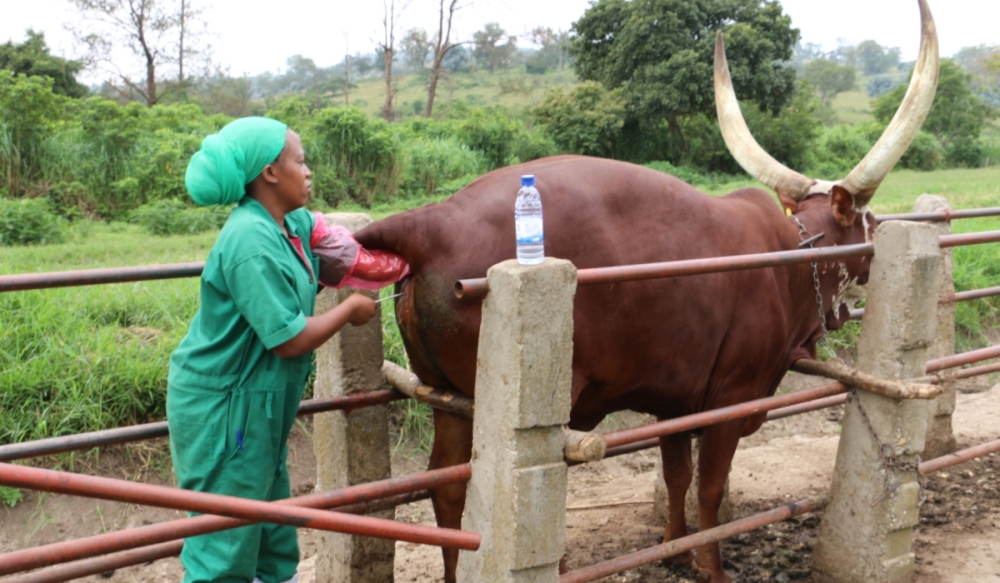

The country plans to increase artificial insemination conception rates in its cattle, from the current 40 per cent to 50 per cent, under the Second National Strategy for Transformation (NST2), according to Rwanda Agriculture and Animal Resources Development Board (RAB).
This initiative is expected to address farmers' complaints about low conception rates in artificial insemination, which have driven some to return to traditional breeding methods.
Solange Uwituze, the Deputy Director-General in charge of animal resources research and technology transfer at RAB, told The New Times that artificial insemination faces challenges such as poor record-keeping, inadequate herd management, irregular supply of materials, technician shortages, and uterine infections, all of which reduce the success rate of artificial insemination.
She outlined key efforts being considered to increase the conception rates for cows.
1. Increasing nitrogen production
In addition to the one in Kigali (Kicukiro) and the one in Huye District, there is a plan to buy a third liquid nitrogen plant to be installed in Kayonza District, she said.
ALSO READ: New semen storage plant set to ease artificial insemination
"The estimated budget is Rwf700 million. Construction works will start this fiscal year, and are set to be completed the next fiscal year.”
ALSO READ: New semen storage plant set to ease artificial insemination
With the increasing adoption of artificial insemination and increasing demand for liquid nitrogen, the two existing plants are no longer capable of satisfying the demand, she admitted.
"A new plant will guarantee liquid nitrogen to reach all inseminators, conserve semen from central stores to artificial insemination sub centers which are projected to increase with the implementation of sanitary mandate, and more uptake of artificial insemination,” she added.
ALSO READ: Lawmakers push for artificial insemination plants in provinces
2. Training and equipping more technicians
According to Uwituze, more technicians will be trained and equipped to offer artificial insemination services locally, improving the quality and reach of insemination services across the country.
3. Implement veterinary sanitary mandate
Uwituze said that the government started the implementation of the veterinary sanitary mandate whereby trained private technicians are partnering with the government to deliver quality services.
Mid this year, Rwanda Council of Veterinary Doctors (RCVD) indicated that the creation of companies, at district level, saving and loan schemes would enable its members to deliver as they take over key veterinary services which government staff were previously providing. The Ministry of Agriculture and Animal Resources on July 25 announced that key veterinary services would be provided by private operators under the ‘Veterinary Sanitary Mandate’ Scheme, with government oversight.
ALSO READ: Veterinary Council Seeks More Professionals to Boost Livestock Enterprises
The new initiative aims to bring veterinary services closer to farmers, establishing a strong link between private veterinarians and the state. The mandate places veterinarians at the service of the state and the public for general interest missions, such as early detection and control of animal diseases.
ALSO READ: Government to Privatize Veterinary Services
4. Establishment of a genetic center of excellence
Uwituze noted that Songa Genetic Center of Excellence will be boosted to improve the availability, diversity, and quality of semen used for artificial insemination.
ALSO READ: Artificial insemination centre to raise cattle production
She explained that in Rwanda, artificial insemination has become the preferred method for breeding cows, due to its benefits, which include access to high-quality genetics, prevention of sexually transmitted diseases like brucellosis, and reduced costs associated with rearing bulls.
Janvier Munyaneza, a livestock farmer in Nyagatare District, described how low conception rates affected his farm, leading him to return to traditional methods despite their disadvantages.
"My four cows were in heat, so I called a veterinarian, but he delayed. The cows were eventually inseminated, but none conceived. The next time, six were in heat again, and although the veterinarian arrived on time, four of them still failed to conceive,” he said.
After experiencing several similar incidents, he again opted for traditional breeding methods, and ended up losing around Rwf200,000 over the last two years due to failures in using artificial insemination.
Uwituze advised farmers to adopt artificial insemination to improve cattle genetics and enhance cow management, particularly in nutrition, health, and timely heat detection for more effective insemination.
According to the 2017 Ministerial Order on veterinary fees, artificial insemination services for large animals cost between Rwf1,000 and Rwf5,000 per service. For small ruminants it cost between Rwf1,000 and Rwf2,000.
Artificial insemination for pigs ranges between Rwf2,000 and Rwf4,000. Bovine embryo transfer (ET) costs between Rwf10,000 and Rwf15,000, while small animal ET costs range from Rwf5,000 to Rwf10,000.


